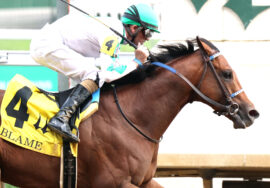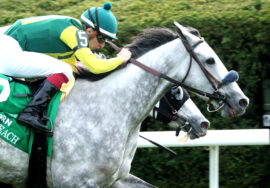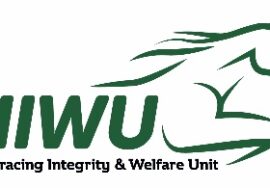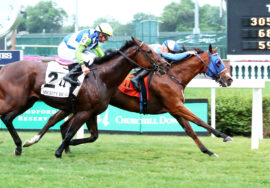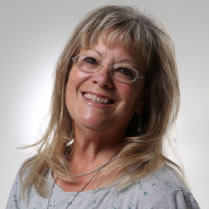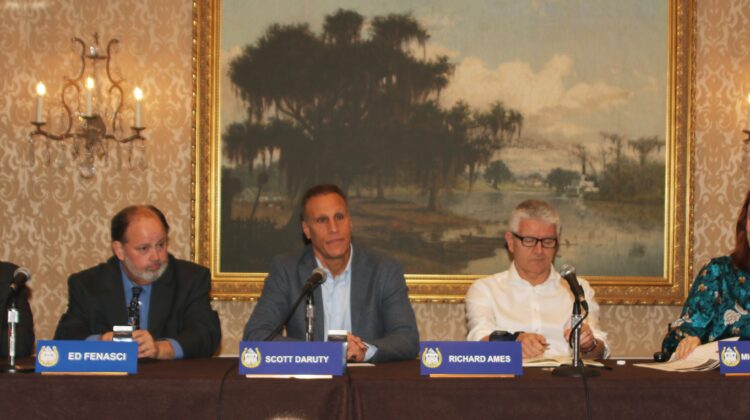
Fixed odds coming to U.S. sports books?
By Jennie Rees, National HBPA communications (photo by Denis Blake/National HBPA)
NEW ORLEANS, La. — Albeit not as dramatically as sports betting is sweeping the country, fixed-odds wagering on horse racing is coming to America and should be embraced as well as understood by horsemen.
That was the advice of two heads of major horse-racing content distributors and two executive directors of horsemen’s associations. They spoke on a closing-day panel at the National Horsemen’s Benevolent & Protective Association conference, which was held in conjunction with the Association of Racing Commissioners International at the Hotel Monteleone.
The panelists addressed both the growth of U.S. tracks sending their race product to legal bookmakers overseas and the possibilities and challenges of introducing bookmaker-style fixed odds as a wagering option at U.S. tracks, whether at the actual track, another bricks-and-mortar facility or online.
“We’ve really had a mantra to educate our members on what’s coming,” said National HBPA CEO Hamelback when introducing what has become an annual panel. “Whatever you decide as a state — to bring it in, not to bring it in, or if you’re fortunate enough to have a sports-wagering license — I believe sports wagering and fixed odds are in our future. But it’s up to us to continue to educate everyone properly on the pros, the cons and the nuances of what’s going on.”
Panel moderator Michele Fischer offered some stats: A total of $44.3 billion globally was wagered in 2022 through legalized fixed odds on horse racing. That’s led by Australia at $19.1 billion and the United Kingdom at $12.9 billion. Sports betting in the United Stakes is predicted to gross $10.2 billion this year and be up to $16 billion in 2026, according to Fischer’s research. The point being: Fixed odds on horse racing is popular around the world, and American tracks need to get into the sports-book action igniting around the country.
American horse racing for more than a century has been based on pari-mutuel wagering — where players are betting against each other and final odds aren’t determined until after wagering closes on a race. With fixed odds betting, players can lock into a price and the competition is against the house, not only for sports betting but for wagering on horses.
Sports betting is now being offered in some form in 36 states and Washington D.C., with the enabling legislation in place in several others and before lawmakers in a few more. Presently only New Jersey and Colorado have implemented fixed-odds wagering on horse racing.
Offering the same structure as sports betting, with its fixed odds, has the potential to grow horse racing’s market, the panelists agreed. But they stressed it will take some time for the industry to reap the full benefits, with the betting public potentially reacting in unexpected ways.
“There are ways in which a low-percentage margin can turn into huge amounts of profitability. But to believe you’re going to know exactly what is happening from Day One is completely unrealistic,” advised Richard Ames, the CEO at the British-based Sports Information Services (SIS) and president of SIS Content Services, the largest horse-racing content supplier to global bookmakers/sports books. “Starting is important. Transparency of the data is important, and then move forward. Not having long-term deals on Day One, or having some flexibility to adapt to the way consumers want to play, that’s the way to approach this challenge.”
The risk of cannibalizing the existing pari-mutuel pools if fixed odds are also offered was discussed at length.
“I think everybody in this room agrees we want to get our racing product in front of the sportsbook customers,” said Scott Daruty, president of U.S.-based Monarch Content Management, the simulcast purchase and sales agent for more than a dozen premier North American tracks. “…. But it’s important that we introduce it in a way that doesn’t hurt our pari-mutuel pools. We have some pretty definitive thoughts on what that means. First and foremost: we believe fixed-odds wagering should be offered on a win and place basis only.”
That brought pushback from Ames, a former executive with Ladbrokes, a market leader in retail bookmaking.
“Going in (saying) we’re going to restrict what you can do misses the point in terms of the sports books’ attitude to horse racing,” Ames said. “We have to remember these sports books are generating huge amounts of revenue, and horse racing comes in late to the party. Those sports books need to want to do it…. It will cost them money to get ready to be able to bring these props into the market, and those props will be competing against other sports. I do recognize the challenge around cannibalization. But I think going into sportsbooks with the attitude, ‘we’ll restrict you from the beginning’ is not going to get them to buy into the production and do it in a way that will maximize the profitability for all.”
Dave Basler, Executive Director of the Ohio HBPA, and Louisiana HBPA Executive Director Ed Fenasci stressed that horsemen need to be informed and part of the decision-making process.
“There’s a strong possibility (fixed odds) could bring a lot more volume in, and any cannibalization is minimal because it brings additional pari-mutuel wagering in through the new volume,” Basler said. “But I don’t know…. If you’re doing $250,000 a day in total handle, you don’t have a lot of downside to trying fixed odds. It’s going to be a different equation to what deal you approve than a Santa Anita that’s betting $10-12 million a day, a lot of it on track.”
Ames and Daruty differed on what deal structure would most benefit American tracks and horsemen. Ames said the industry seems to be settling on a set-up based on a percentage of the revenue, whether on the gross or net.
“Either way, the bookmaker pays a percentage share of the revenue they take” as opposed to a flat per-card fee, he said. “The reason we would generally favor that is because it would mean everybody has the same interest: how do we maximize the value of the content?
“One of the challenges with the economics of fixed-odds betting is that the numbers look quite different than they do on pari-mutuel. The idea of ‘takeout’ in the teens or 20 cents versus the expectation of a share of the turnover (betting) that might be 2 percent. Those numbers look very different. It doesn’t mean they can’t deliver more money in the long run, but in the short run they’re quite difficult to get your head around. It needs to be incremental. I’d recommend in general having a shared approach with the bookmaker. That means everybody is talking the same language.”
Daruty offered a different perspective. “I think it’s important that you don’t get too caught up in taking a little tiny piece because it’s going to be a big, big pot,” he said. “That’s great, and maybe you do in a new market. But again, if you’re cannibalizing your parimutuel pools, you end up losing money in the long run.
“What we want to make sure never happens is our horse racing is used as a loss-leader product. You take a horse that should be 5-1, and the sports books are competing so one book offers 6-1 and one offers 7-1. Ultimately they’re not making any money on that race, but they’re using it to attract customers. And guess what? You get a share of their profit on that, which is zero. All you’ve done is move people out of your parimutuel pools and into fixed odds.”
Fischer, a Louisville-based industry consultant who serves as vice president of SIS Content Services, asked why not just add pari-mutuel wagering to U.S. sportsbooks? Daruty said that might be the answer.
Daruty — whose corporate ownership includes Santa Anita and Gulfstream Park in its racetrack portfolio — said the biggest form of betting in the United States is the lottery “which is a form of pari-mutuel wagering.
“I’m not saying we’re opposed to fixed-odds racing, but we look at it very cautiously and very carefully,” he said. “I think if there’s one thing we’d all agree is that we need to get our racing product in front of all these sports-betting customers. Our company is very open to fixed odds, but only if we can do it in a controlled, measured way that doesn’t undercut our business.”
Back to Ames: “Everything going on in those sports books is fixed odds. The idea you will try to force those consumers, who are a big incremental opportunity, to have to learn to bet in a different way, that seems to me to be counterintuitive… I think to really take the opportunity of these sports books there has to be a fixed-odds solution. That doesn’t mean there can’t be a parimutuel solution as well.”
Meanwhile, the American racing product is coveted by content distributors because they are trying to provide betting products around the clock to their global clients.
Daruty said his company’s initial foray into the international market was “an utter failure.” Success came when they started offering the odds to the overseas books and tailoring the packaging to individual markets overseas. That included hiring a team to call the races in the local language on a second audio feed.
Fenesci said he was surprised to find out last summer that Louisiana Downs’ best overseas outlet was Spain, saying, “When I’m looking at these contracts, it was very important for horsemen to get the feedback exactly where the product is going and what is the volume that is being generated in those markets, so that you can continually evaluate and make good decisions.”
The Ohio and Louisiana horsemen have been at the forefront of ensuring their purses benefit from overseas betting on their races.
“It is imperative that your product get into as many bookshops as you can,” Fenasci said. “…. When you’re dealing with distribution, you want to work with reputable companies that have the relationships around the world to get your content the widest distribution. We’ve had long-term agreements with our racetracks that our purses will share in revenue generated directly from horse racing.”
Basler said the Ohio horsemen handle it through their domestic simulcast approvals. “They are very specific that in order to sell U.S. content within the U.S. or outside the U.S., all sites have to be disclosed to us and approved and we have to receive our share of that revenue,” he said.




